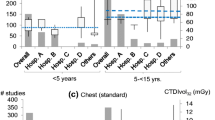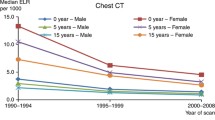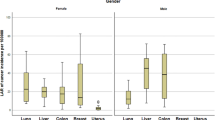Abstract
Background
The increasing absolute number of paediatric CT scans raises concern about the safety and efficacy and the effects of consecutive diagnostic ionising radiation.
Objective
To demonstrate a method to evaluate the lifetime attributable risk of cancer incidence/mortality due to a single low-dose helical chest CT in a two-year patient cohort.
Materials and methods
A two-year cohort of 522 paediatric helical chest CT scans acquired using a dedicated low-dose protocol were analysed retrospectively. Patient-specific estimations of radiation doses were modelled using three different mathematical phantoms. Per-organ attributable cancer risk was then estimated using epidemiological models. Additional comparison was provided for naturally occurring risks.
Results
Total lifetime attributable risk of cancer incidence remains low for all age and sex categories, being highest in female neonates (0.34%). Summation of all cancer sites analysed raised the relative lifetime attributable risk of organ cancer incidence up to 3.6% in female neonates and 2.1% in male neonates.
Conclusion
Using dedicated scan protocols, total lifetime attributable risk of cancer incidence and mortality for chest CT is estimated low for paediatric chest CT, being highest for female neonates.


Similar content being viewed by others
References
Euratom FP6 project: safety and efficacy in computed tomography (CT): a broad perspective (2005-2007) AZ: FP6/002388 : www.msct.eu. July 2013
Bernier M-O, Rehel J-L, Brisse HJ et al (2012) Radiation exposure from CT in early childhood: a french large-scale multicentre study. Br J Radiol 85:53–60
Baysson H, Etard C, Brisse HJ et al (2012) Diagnostic radiation exposure in children and cancer risk: current knowledge and perspectives. Arch Pediatr 19:64–73
Kleinerman RA (2006) Cancer risks following diagnostic and therapeutic radiation exposure in children. Pediatr Radiol 36:121–125
Shuryak I, Sachs RK, Brenner DJ (2011) A new view of radiation-induced cancer. Radiat Prot Dosim 143:358–364
Eckerman KF, Leggett RW, Nelson CB et al (1999) Cancer risk coefficients for environmental exposure to radionuclides, federal guidance report no.13, EPA 402-R-99-001. Oak Ridge National Laboratory, Oak Ridge, TN
Brenner D, Elliston C, Hall E et al (2001) Estimated risks of radiation-induced fatal cancer from pediatric CT. AJR Am J Roentgenol 176:289–296
Krille L, Zeeb H, Jahnen A et al (2012) Computed tomographies and cancer risk in children: a literature overview of CT practices, risk estimations and an epidemiologic cohort study proposal. Radiat Environ Biophys 51:103–111
Bauhs JA, Vrieze TJ, Primak AN et al (2008) CT dosimetry: comparison of measurement techniques and devices. Radiographics 28:245–253
Niemann T, Zbinden I, Roser HW et al (2013) Computed tomography for pulmonary embolism: assessment of a 1-year cohort and estimated cancer risk associated with diagnostic irradiation. Acta Radiol 54:778–784
Rogers DW (2006) Fifty years of Monte Carlo simulations for medical physics. Phys Med Biol 51:R287–301
Stamm G, Nagel HD (2002) CT-expo – a novel program for dose evaluation in CT. Röfo 174:1570–1576
Munk RD, Strohm PC, Saueressig U et al (2009) Effective dose estimation in whole-body multislice CT in paediatric trauma patients. Pediatr Radiol 39:245–252
Zankl M, Panzer W, Drexler G (1993) Organ doses from computed tomography examinations in paediatric radiology. National Research Centre for Environment and Health (GSF), Neuherberg
Khursheed A, Hillier MC, Shrimpton PC et al (2002) Influence of patient age on normalized effective doses calculated for CT examinations. Br J Radiol 75:819–830
Deak PD, Smal Y, Kalender WA (2010) Multisection CT protocols: sex- and age-specific conversion factors used to determine effective dose from dose-length product. Radiology 257:158–166
The 2007 Recommendations of the International Commission on Radiological Protection. ICRP publication 103 (2007) Ann ICRP 37:1-332
Tian X, Li X, Segars WP et al (2014) Pediatric chest and abdominopelvic CT: organ dose estimation based on 42 patient models. Radiology 270:535–547
Li X, Samei E, Segars WP et al (2011) Patient-specific radiation dose and cancer risk for pediatric chest CT. Radiology 259:862–874
National Research Council of the National Academies (2006) Health risks from exposure to low levels of ionizing radiation: BEIR VII phase 2. National Academy Press, Washington, DC
Horner MJ (2010) SEER cancer statistics review, 1975-2007. National Institutes of Health, Bethesda, MD
Nievelstein RAJ, van Dam IM, van der Molen AJ (2010) Multidetector CT in children: current concepts and dose reduction strategies. Pediatr Radiol 40:1324–1344
Lell MM, May M, Deak P (2011) High-pitch spiral computed tomography: effect on image quality and radiation dose in pediatric chest computed tomography. Invest Radiol 46:116–123
Theocharopoulos N, Damilakis J, Perisinakis K et al (2007) Energy imparted-based estimates of the effect of z overscanning on adult and pediatric patient effective doses from multi-slice computed tomography. Med Phys 34:1139–1152
Hall EJ, Brenner DJ (2008) Cancer risks from diagnostic radiology. Br J Radiol 81:362–378
McCollough CH, Leng S, Yu L et al (2011) CT dose index and patient dose: they are not the same thing. Radiology 259:311–316
Land CE (2009) Low-dose extrapolation of radiation health risks: some implications of uncertainty for radiation protection at low doses. Health Phys 97:407–415
Zankl M, Veit R, Williams G et al (1988) The construction of computer tomographic phantoms and their application in radiology and radiation protection. Radiat Environ Biophys 27:153–164
Brisse HJ, Robilliard M, Savignoni A et al (2009) Assessment of organ absorbed doses and estimation of effective doses from pediatric anthropomorphic phantom measurements for multi-detector row CT with and without automatic exposure control. Health Phys 97:303–314
Hendee WR, O’Connor MK (2012) Radiation risks of medical imaging: separating fact from fantasy. Radiology 264:312–321
Ivanov VK, Tsyb AF, Mettler FA et al (2012) Methodology for estimating cancer risks of diagnostic medical exposure: with an example of the risks associated with computed tomography. Health Phys 103:732–739
Pearce MS, Salotti JA, Little MP et al (2012) Radiation exposure from CT scans in childhood and subsequent risk of leukaemia and brain tumours: a retrospective cohort study. Lancet 380:499–505
Mathews JD, Forsythe AV, Brady Z et al (2013) Cancer risk in 680,000 people exposed to computed tomography scans in childhood or adolescence: data linkage study of 11 million australians. BMJ 346:f2360
Acknowledgments
This study was financially supported by the Cancer League of Basel-City and Basel-Country and the Gottfried and Julia Bangerter-Rhyner Foundation. The study sponsors had no role in matters of design, collection, analysis, interpretation of data, and writing the report.
Conflicts of interest
None
Author information
Authors and Affiliations
Corresponding author
Rights and permissions
About this article
Cite this article
Niemann, T., Colas, L., Roser, H.W. et al. Estimated risk of radiation-induced cancer from paediatric chest CT: two-year cohort study. Pediatr Radiol 45, 329–336 (2015). https://doi.org/10.1007/s00247-014-3178-7
Received:
Revised:
Accepted:
Published:
Issue Date:
DOI: https://doi.org/10.1007/s00247-014-3178-7




